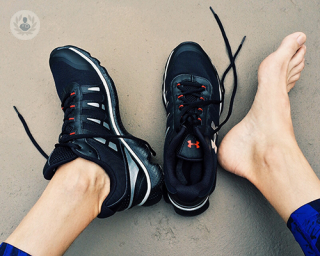Ankle arthrodesis
What is ankle arthrodesis?
An ankle arthrodesis, also known as ankle fusion, is a surgical procedure to join together two bones in the ankle to take away pain.
Why is ankle arthrodesis performed?
Ankle arthrodesis is most commonly performed to treat severe and painful arthritis, a degenerative condition which affects your joints. For most patients, arthritis can be managed with conservative treatments such as physiotherapy and anti-inflammatory drugs.

However, if these treatments fail to relieve the pain sufficiently, surgery may be considered. Ankle arthrodesis is also carried in some cases of foot deformity, where the bones are misaligned and causing problems with walking.
When is ankle arthrodesis not recommended?
Ankle arthrodesis is not recommended where there is not enough bone to fuse, when the nerves in the ankle are severely damaged, and when the blood supply to the ankle is poor.
What are the possible complications of ankle arthrodesis?
Although uncommon, some patients can experience complications during or following diagnostic and surgical ankle arthrodesis. They include infection, phlebitis (inflammation of a vein), excessive swelling or bleeding, blood clots, and damage to blood vessels and nerves. On rare occasions, the small instruments break during the operation. There are also risks associated with the anaesthetic, both during its administration and after the arthroscopy.
What does the procedure involve?
Ankle arthrodesis may be carried out as an open or minimally invasive procedure. In both situations, an incision is made to gain access to the ankle joint and tools are used to remove the cartilage.The bones are held together with metalwork – usually screws or a plate. Finally, the incision is closed with stitches and the ankle placed in a splint to keep it stable.
What is recovery time like?
After your operation, you will need to keep the ankle elevated to minimise any swelling. You will, generally speaking, be in a cast for six weeks and then into a removable splint. You will need a crutch or walker in the early period to help you get around. After three months, you should be able to wear normal footwear but the final outcome will take several months.
What are the possible complications of ankle arthrodesis?
Although uncommon, complications do occur occasionally during or following diagnostic and surgical ankle arthrodesis. They include infection, phlebitis (inflammation of a vein), excessive swelling or bleeding, blood clots, and damage to blood vessels and nerves. On rare occasions, the small instruments break during the operation. There are also risks associated with the anaesthetic, both during its administration and after the arthroscopy.
Should I expect a lot of swelling after an ankle arthrodesis?
Some swelling is to be expected. Normally, the patient's swelling increases gradually for the first two to three days. If the bandage feels tight, you should re-apply it more lightly and elevate the leg to reduce the swelling. Applying ice packs for 20 to 30 minutes every few hours may help to reduce the swelling and act as pain relief as required.
Will I need crutches after ankle arthrodesis surgery?
It is important to note that weight bearing is not usually possible after ankle arthrodesis surgery. Crutches or some form of weight support may be recommended by your surgeon depending on the operation. Once pain eases for patients, it is important to gradually increase weight bearing on the leg.
What should patients do after an ankle arthrodesis and in the long run?
Patients who have undergone an ankle arthrodesis are advised to maintain a normal body weight, engage in low impact exercises, and to maintain as healthy a diet as possible.







